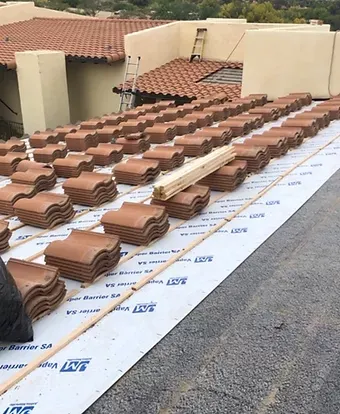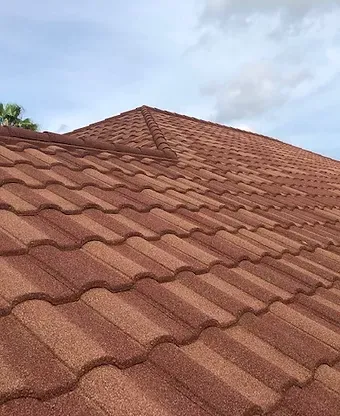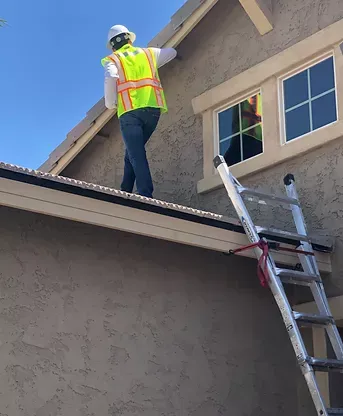A Homeowner's Guide to Tile Roof Costs in Southwest Florida
A Homeowner's Guide to Tile Roof Costs in Southwest Florida
Introduction: Why Consider Tile Roofing in Southwest Florida?
Tile roofing has long been a staple of Southwest Florida’s architectural landscape , thanks to its ability to withstand the region’s harsh climate while adding timeless beauty. With intense heat, high humidity, and frequent storms, homeowners in this area need roofing materials that can endure extreme conditions without compromising on style. Tile roofs excel in both durability and aesthetics, making them an attractive choice for those seeking a long-term solution. Additionally, their popularity is bolstered by their compatibility with the Mediterranean and Spanish-inspired designs that dominate the region.
Beyond their visual appeal, tile roofs offer practical benefits that make them a smart investment. Many homeowners explore tile roofing because of its resistance to fire, wind, and pests , which are common concerns in Southwest Florida. The material’s ability to reflect sunlight also helps reduce cooling costs during the scorching summer months. As you consider your roofing options, it’s worth diving deeper into the costs and considerations associated with tile roofs, as they can significantly enhance both the functionality and value of your home.
Average Tile Roof Costs in Southwest Florida
The cost of installing a tile roof in Southwest Florida typically ranges from $10,000 to $35,000, depending on the size and complexity of the project. For smaller homes, the price might fall on the lower end of the spectrum, while larger or more intricate roofs can push costs toward the higher end. On average, homeowners can expect to pay between $10 and $25 per square foot, with the total expense influenced by factors like roof pitch, design features, and material selection. Understanding these variables is key to budgeting effectively for your roofing project.
Regional factors also play a significant role in determining tile roof costs in Southwest Florida. The demand for hurricane-resistant materials, local labor rates, and compliance with strict building codes can all drive prices up compared to other parts of the country. While these costs may seem steep, they often reflect the added value of a roof designed to protect against the unique challenges of the area’s weather patterns. This makes investing in a quality tile roof a decision that pays off over time.
Major Factors Affecting Tile Roof Cost
Several key factors influence the overall cost of a tile roof, starting with the type of material chosen. Clay, concrete, synthetic, and slate tiles each come with their own price tags and installation requirements. The size and design of the roof also matter, as larger or more complex structures require additional materials and labor. Other variables include the roof’s slope and the level of detail involved in the installation process. Each of these elements contributes to the final price, so it’s important to plan carefully and consult with professionals.
For homeowners replacing an existing roof , removal and disposal of old materials can add significantly to the total cost. Tearing off shingles or tiles and preparing the surface for new installation requires time and effort, which translates to higher labor expenses. In some cases, additional structural work may be needed to support the weight of tile roofing, further increasing the budget. These steps are essential for ensuring a safe and durable installation, but they should be factored into your financial planning from the start.
Skilled labor is another critical component of tile roof costs, especially when working with intricate designs or challenging layouts. Installing tile roofs requires expertise to ensure proper alignment, water resistance, and longevity. Contractors with experience in Southwest Florida’s unique climate and building codes can provide peace of mind, knowing your roof will perform well for decades. While labor costs can account for 40–60% of the total expense, investing in qualified professionals is crucial for avoiding costly mistakes down the line.
Types of Tile Materials and Their Costs
When choosing tile roofing, homeowners have several material options, each with distinct costs and characteristics. Clay tiles are among the most popular due to their classic appearance and exceptional durability, but they tend to be on the pricier side, ranging from $15 to $30 per square foot. Concrete tiles offer a more affordable alternative , costing $10 to $20 per square foot, while still providing excellent performance. Synthetic tiles, made from composite materials, are gaining traction for their lightweight design and lower price point, typically around $8 to $15 per square foot. Slate tiles, though less common, are prized for their luxury appeal but come with a premium price tag.
In addition to material type, the shape and style of tiles can impact costs. Flat tiles are generally less expensive than curved or specialty designs, which require more precise manufacturing and installation techniques. Specialty tiles, such as those with custom textures or colors, can elevate the aesthetic of your home but may also increase the overall expense. Understanding these differences allows you to balance your budget with your desired look and functionality.
Each material has its pros and cons beyond cost. Clay tiles are known for their longevity and heat resistance but are heavier and may require structural reinforcement. Concrete tiles are durable and versatile but can be prone to cracking under extreme stress. Synthetic tiles offer affordability and ease of installation but may not match the authenticity of natural materials. Slate tiles provide unmatched elegance and durability but are heavy and costly. By weighing these factors, you can select the best option for your Southwest Florida home.
Installation versus Replacement: What to Expect
Installing a new tile roof differs significantly from replacing an existing one, particularly in terms of cost and complexity. New installations typically involve fewer preparatory steps, as there’s no need to remove old materials or address underlying damage. However, replacement projects often include tear-off and disposal fees, which can add $1,000 to $3,000 to the total expense. If the existing roof structure isn’t suitable for tile, additional reinforcement may be necessary, further increasing costs. It’s important to assess your current roof’s condition before deciding whether to install or replace.
Before committing to a full replacement, consider whether repairs or upgrades could extend the life of your existing roof. Minor fixes, such as replacing broken tiles or addressing leaks , might be more cost-effective in the short term. On the other hand, if your roof is nearing the end of its lifespan or has sustained significant damage, replacement may be the better option. Consulting with a professional can help you determine the most practical and economical path forward for your Southwest Florida home.
Labor Costs and Finding Qualified Contractors
Labor costs make up a substantial portion of any tile roof project, often accounting for 40–60% of the total expense. This reflects the skill and precision required to install tile roofs, especially on complex or steeply pitched surfaces. Projects involving intricate designs or specialized materials may see labor costs rise even higher. While hiring experienced contractors may seem expensive upfront, it ensures a proper installation that minimizes the risk of future issues. Cutting corners on labor can lead to costly repairs or replacements down the road.
To find qualified contractors in Southwest Florida , start by asking for recommendations from friends, family, or neighbors who have recently completed similar projects. Research potential candidates online, paying attention to reviews and ratings. Verify licenses, insurance, and certifications to confirm they meet local standards. Request detailed quotes from multiple contractors, comparing not only prices but also timelines and warranties. Taking these steps will help you choose a reliable professional who delivers quality results.
Long-Term Value: Durability, Lifespan, and Energy Efficiency
While tile roofs come with a higher upfront cost, their long-term value makes them a worthwhile investment for many homeowners. These roofs are incredibly durable, often lasting 50 years or more with proper maintenance. Their resistance to fire, rot, and insect damage reduces repair and replacement needs, saving money over time. Additionally, tile roofs contribute to energy efficiency by reflecting sunlight and reducing heat absorption, which can lower cooling bills in Southwest Florida’s hot climate.
Another advantage of tile roofs is their ability to withstand severe weather events, including hurricanes. Many insurance companies offer discounts for homes with wind-resistant roofing materials, further offsetting the initial expense. When combined with their extended lifespan and minimal maintenance requirements, these benefits make tile roofs a financially sound choice for homeowners looking to maximize their property’s value and resilience.
Hidden Costs and Budgeting Tips
Beyond the obvious expenses of materials and labor, several hidden costs can arise during a tile roof project. Permitting fees, for example, are often required to ensure compliance with local building codes. Upgrading the underlayment or reinforcing the roof structure to support the weight of tiles can also add to the budget. Gutter work or drainage improvements may be necessary to prevent water damage, particularly in areas prone to heavy rainfall. Being aware of these potential costs helps avoid surprises during the installation process.
To budget effectively, start by obtaining detailed estimates from multiple contractors. Be sure to specify the materials and design you’re considering, as this will impact pricing. Ask about any additional charges that might apply, such as disposal fees or structural reinforcements. Planning ahead and setting aside a contingency fund for unexpected expenses can provide peace of mind. By taking a proactive approach, you’ll be better prepared to manage the financial aspects of your tile roof project.
Financing and Insurance Considerations
Financing a tile roof installation can be manageable with the right strategy, especially given the high upfront costs. Options such as personal loans, home equity lines of credit (HELOCs), or special financing programs offered by contractors can help spread out payments over time. Some lenders even provide low-interest rates for home improvement projects that increase property value, making these options appealing for Southwest Florida homeowners. Exploring these avenues allows you to invest in a quality roof without straining your finances.
Insurance plays a vital role in protecting your investment in a tile roof. Many policies offer discounts for roofs made from wind-resistant materials, potentially lowering your premiums. Documenting your roof’s installation and any upgrades can streamline the claims process in case of damage. It’s also wise to review your policy regularly to ensure adequate coverage. By understanding the interplay between financing and insurance, you can make informed decisions that safeguard your home and wallet.
Comparing Tile to Other Roofing Options in Southwest Florida
When evaluating roofing options, tile stands out for its durability and aesthetic appeal but comes at a higher cost than alternatives like asphalt shingles or metal. Asphalt shingles are the most affordable choice, averaging $3 to $7 per square foot, but they lack the longevity and weather resistance of tile. Metal roofs , priced between $10 and $20 per square foot, offer excellent durability and energy efficiency but may not match the classic charm of tile. Each material has its strengths, so it’s important to weigh cost against performance and personal preference.
Beyond functionality, resale value and curb appeal are worth considering. Tile roofs can significantly enhance a home’s visual appeal and marketability, potentially increasing its value. They align well with Southwest Florida’s architectural styles, making them a popular choice among buyers. While the initial investment may be higher, the long-term benefits of tile roofing often justify the expense, especially for homeowners planning to stay in their homes for years to come.
Common Issues with Tile Roofs and Maintenance Planning
Tile roofs are remarkably durable, but they aren’t immune to wear and tear. Over time, individual tiles may crack or break due to falling debris, foot traffic, or extreme weather. Repairs for damaged tiles can range from $50 to $200 per tile, depending on the material and complexity of the fix. Regular inspections are essential for identifying issues early and preventing minor problems from escalating into major repairs. Proactive maintenance ensures your roof remains in top condition for decades.
Preventive care is key to minimizing long-term costs. Simple tasks like clearing debris from gutters, trimming overhanging branches, and checking for loose tiles can go a long way in extending your roof’s lifespan. Consider scheduling annual inspections with a qualified contractor to catch potential issues before they become costly. By staying vigilant and addressing problems promptly, you can enjoy the full benefits of your tile roof while keeping expenses in check.
How to Get an Accurate Estimate for Your Home
Obtaining an accurate estimate for your tile roof project begins with thorough research and preparation. Start by gathering multiple bids from reputable contractors, as this allows you to compare prices and services. Be specific about the materials and design you want, as these details will directly affect the quote. During site inspections, ask questions about the scope of work, timelines, and any additional costs that might arise. Clear communication ensures everyone is on the same page from the outset.
Local recommendations and reviews can be invaluable resources when vetting contractors. Seek out testimonials from past clients to gauge reliability and quality of work. Don’t hesitate to inquire about certifications, licenses, and warranties to verify professionalism. A detailed written estimate that outlines all costs and timelines is a must-have before committing to any project. By following these steps, you’ll set yourself up for a successful and transparent roofing experience.
Frequently Asked Questions about Tile Roof Costs
-
How much does a tile roof cost per square foot in Southwest Florida?
In Southwest Florida, tile roof costs typically range from $10 to $25 per square foot, depending on the type of tile and the complexity of the project. Factors such as material choice, roof size, and design intricacy can influence where your project falls within this range. Understanding these variables helps you anticipate expenses and plan accordingly.
-
What’s the difference in cost between clay and concrete tiles?
Clay tiles are generally more expensive than concrete tiles, with prices ranging from $15 to $30 per square foot compared to $10 to $20 for concrete. The higher cost of clay reflects its superior durability, classic appearance, and production process. While both materials offer excellent performance, concrete provides a more budget-friendly alternative without sacrificing quality.
-
Do tile roofs require reinforced roof structures?
Tile roofs are heavier than other roofing materials, so reinforcement may be necessary to support their weight. Costs for structural upgrades vary based on the extent of the work required. Contractors assess the existing roof structure to determine if reinforcement is needed, ensuring safety and compliance with building codes. This step is crucial for avoiding potential issues later on.
-
How long do tile roofs last in Southwest Florida’s climate?
Tile roofs in Southwest Florida can last 50 years or more with proper maintenance. Their longevity is influenced by factors such as material quality, installation practices, and ongoing care. Regular inspections and timely repairs help maximize their lifespan, making them a durable and reliable choice for the region’s challenging weather conditions.
-
Are there cost-saving tips for replacing a tile roof?
Scheduling your project during the offseason or bundling repairs with replacements can help reduce costs. Additionally, obtaining multiple quotes and negotiating terms with contractors may yield savings. Opting for simpler designs and standard materials rather than custom options can also lower expenses. Planning ahead and exploring these strategies ensures you get the best value for your investment.
Conclusion
Understanding the costs and considerations associated with tile roofing is essential for making informed decisions about your Southwest Florida home. From material selection and labor expenses to long-term value and maintenance, each aspect plays a role in shaping your roofing experience. By recognizing the factors that influence costs, you can create a realistic budget and prioritize quality craftsmanship. Investing in a tile roof not only enhances your home’s durability and curb appeal but also provides lasting peace of mind.
If you’re ready to move forward, take the time to seek multiple quotes, research local contractors, and consult with experts who understand the unique needs of Southwest Florida homes. With careful planning and professional guidance, you can achieve a beautiful, resilient roof that meets your expectations and stands the test of time.




